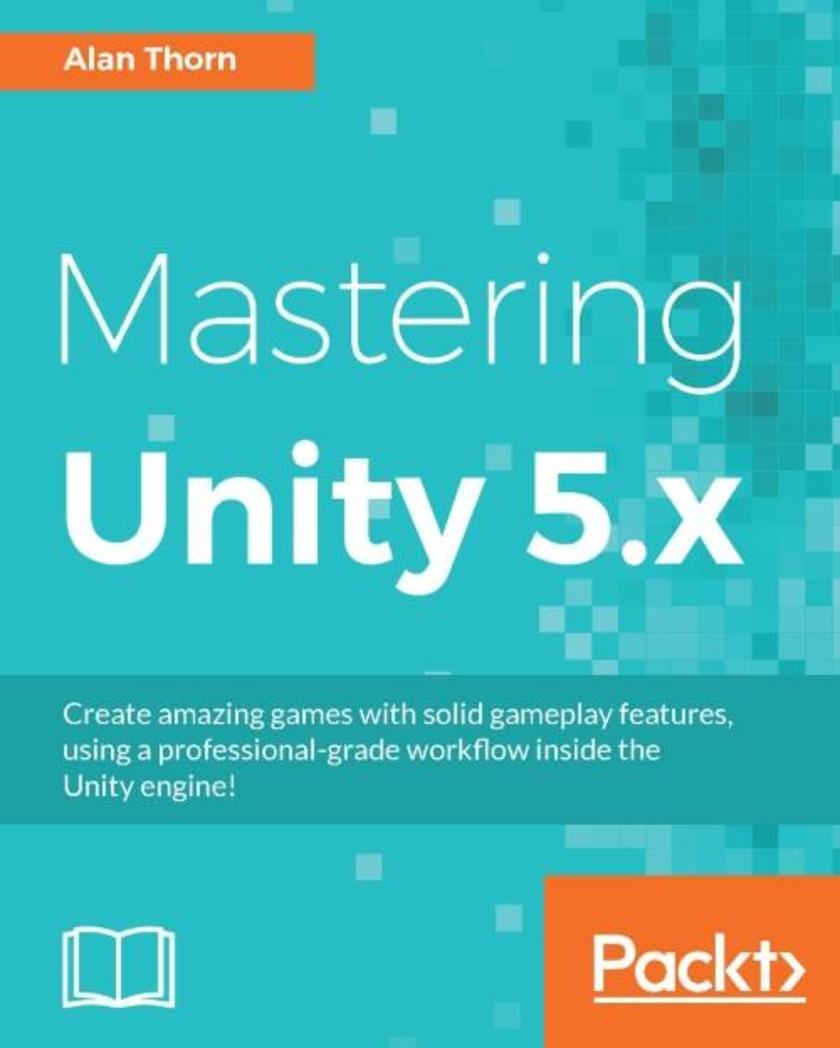
Mastering Unity 5.x
¥90.46
Create amazing games with solid gameplay features, using a professional-grade workflow inside the Unity engine! About This Book Become a Unity master by creating a practical, in-depth game-development project with Unity Use advanced C# *ing to unlock the complete potential of Unity 5 Use Version Control to Effectively Manage and Scale your workflow Who This Book Is For If you are a Unity developer who now wants to develop and deploy interesting games by leveraging the new features of Unity 5.x, then this is the book for you. Basic knowledge of C# programming is assumed. What You Will Learn Explore hands-on tasks and real-world scenarios to make a Unity horror adventure game Create enemy characters that act intelligently and make reasoned decisions Use data files to save and restore game data in a way that is platform-agnostic Get started with VR development Use Navigation Meshes, Occlusion Culling, and the Profiler tools Work confidently with GameObjects, Rotations, and Transformations Understand specific gameplay features such as AI enemies, inventory systems, and level design In Detail Do you want to take the leap from being an everyday Unity developer to being a pro game developerThen look no further! This book is your one stop solution to creating mesmerizing games with lifelike features and amazing gameplay. This book takes an in-depth focus on a practical project with Unity, building a first-person game with many features. You’ll dive deep into the architecture of a Unity game, creating expansive worlds, interesting render effects, and other features to make your games special. You will create individual game components, use efficient animation techniques, and implement collision and physics effectively. Specifically, we’ll explore optimal techniques for importing game assets, such as meshes and textures; tips and tricks for effective level design; how to animate and * NPCs; how to configure and deploy to mobile devices; how to prepare for VR development; and how to work with version control, and more. By the end of this book, you’ll have developed sufficient competency in Unity development to produce fun games with confidence. Style and approach This book takes a step-by-step, practical tutorial approach. You will create an advanced level Unity game with an emphasis on leveraging the advanced Unity 5 features. You will make the most of the Unity 5 advanced features while you develop the game in its entirety.

Mastering SFML Game Development
¥80.65
Create complex and visually stunning games using all the advanced features available in SFML development About This Book Build custom tools, designed to work with your specific game. Use raw modern OpenGL and go beyond SFML. Revamp your code for better structural design, faster rendering, and flashier graphics. Use advanced lighting techniques to add that extra touch of sophistication. Implement a very fast and efficient particle system by using a cache-friendly design. Who This Book Is For This book is ideal for game developers who have some basic knowledge of SFML and also are familiar with C++ coding in general. No knowledge of OpenGL or even more advanced rendering techniques is required. You will be guided through every bit of code step by step. What You Will Learn Dive deep into creating complex and visually stunning games using SFML, as well as advanced OpenGL rendering and shading techniques Build an advanced, dynamic lighting and shadowing system to add an extra graphical kick to your games and make them feel a lot more dynamic Craft your own custom tools for editing game media, such as maps, and speed up the process of content creation Optimize your code to make it blazing fast and robust for the users, even with visually demanding scenes Get a complete grip on the best practices and industry grade game development design patterns used for AAA projects In Detail SFML is a cross-platform software development library written in C++ with bindings available for many programming languages. It provides a simple interface to the various components of your PC, to ease the development of games and multimedia applications. This book will help you become an expert of SFML by using all of its features to its full potential. It begins by going over some of the foundational code necessary in order to make our RPG project run. By the end of chapter 3, we will have successfully picked up and deployed a fast and efficient particle system that makes the game look much more ‘alive’. Throughout the next couple of chapters, you will be successfully editing the game maps with ease, all thanks to the custom tools we’re going to be building. From this point on, it’s all about making the game look good. After being introduced to the use of shaders and raw OpenGL, you will be guided through implementing dynamic scene lighting, the use of normal and specular maps, and dynamic soft shadows. However, no project is complete without being optimized first. The very last chapter will wrap up our project by making it lightning fast and efficient. Style and approach This book uses a step by step approach by breaking the problems down into smaller, much more manageable obstacles, and guiding the reader through them with verified, flexible, and autonomous solutions.

NHibernate 4.x Cookbook - Second Edition
¥90.46
Over 90 incredible and powerful recipes to help you efficiently use NHibernate in your application About This Book · Master the full range of NHibernate features through detailed example recipes that you can quickly apply to your own applications· Reduce hours of application development time and get a better application architecture and improved performance· Create, maintain, and update your database structure automatically with the help of NHibernate Who This Book Is For This book is written for .NET developers who want to use NHibernate and those who want to deepen their knowledge of the platform. Examples are written in C# and XML. Some basic knowledge of SQL is assumed. If you build .NET applications that use relational databases, this book is for you. What You Will Learn · Create a persistent object model to move data in and out of your database· Build the database from your model automatically· Configure NHibernate for use with WebForms, MVC, WPF, and WinForms applications· Create database queries using a variety of methods· Improve the performance of your applications using a variety of techniques· Build an infrastructure for fast, easy, test-driven development of your data access layer· Implement entity validation, auditing, full-text search, horizontal partitioning (sharding), and spatial queries using NHibernate Contrib projects In Detail NHibernate is a mature, flexible, scalable, and feature-complete open source project for data access. Although it sounds like an easy task to build and maintain database applications, it can be challenging to get beyond the basics and develop applications that meet your needs perfectly. NHibernate allows you to use plain SQL and stored procedures less and keep focus on your application logic instead. Learning the best practices for a NHibernate-based application will help you avoid problems and ensure that your project is a success. The book will take you from the absolute basics of NHibernate through to its most advanced features, showing you how to take full advantage of each concept to quickly create amazing database applications. You will learn several techniques for each of the four core NHibernate tasks—configuration, mapping, session and transaction management, and querying—and which techniques fit best with various types of applications. In short, you will be able to build an application using NHibernate by the end of the book. You will also learn how to best implement enterprise application architecture patterns using NHibernate, leading to clean, easy-to-understand code and increased productivity. In addition to new features, you will learn creative ways to extend the NHibernate core, as well as gaining techniques to work with the NHibernate search, shards, spatial, envers, and validation projects. Style and approach This book contains recipes with examples organized in functional areas, each containing step-by-step instructions on everything necessary to execute a particular task. The book is designed so you can read it from start to end or just open up any chapter and start following the recipes.
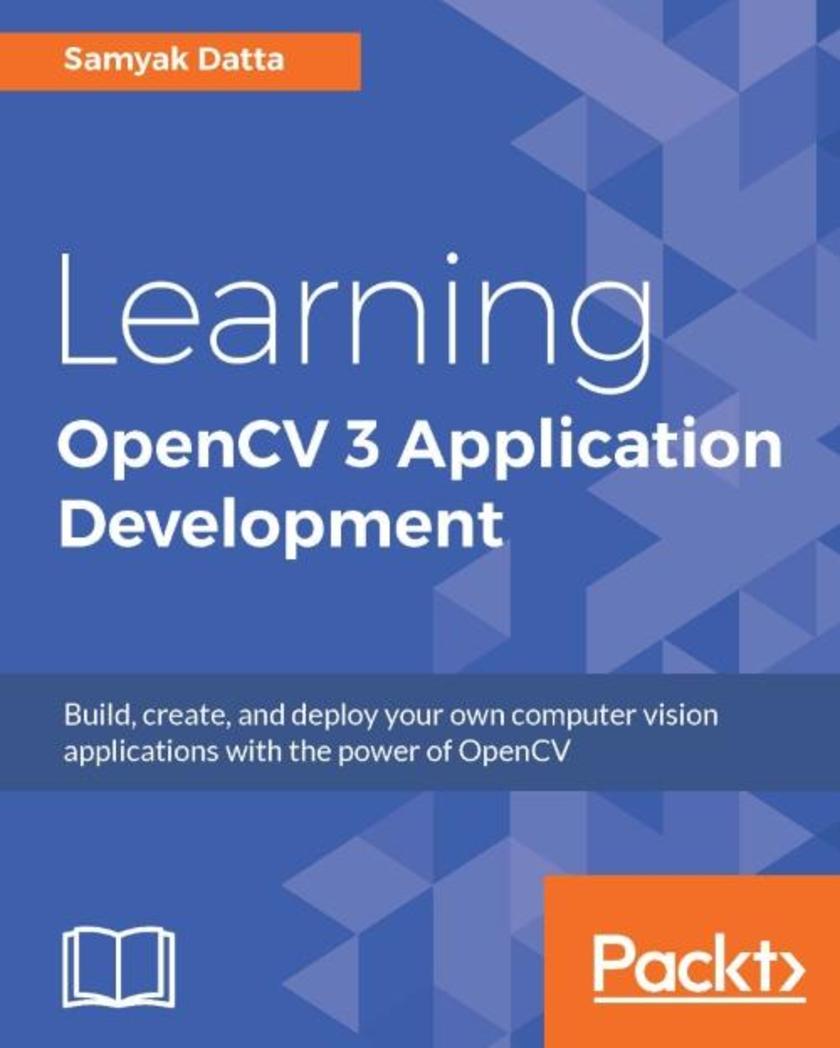
Learning OpenCV 3 Application Development
¥90.46
Build, create, and deploy your own computer vision applications with the power of OpenCV About This Book This book provides hands-on examples that cover the major features that are part of any important Computer Vision application It explores important algorithms that allow you to recognize faces, identify objects, extract features from images, help your system make meaningful predictions from visual data, and much more All the code examples in the book are based on OpenCV 3.1 – the latest version Who This Book Is For This is the perfect book for anyone who wants to dive into the exciting world of image processing and computer vision. This book is aimed at programmers with a working knowledge of C++. Prior knowledge of OpenCV or Computer Vision/Machine Learning is not required. What You Will Learn Explore the steps involved in building a typical computer vision/machine learning application Understand the relevance of OpenCV at every stage of building an application Harness the vast amount of information that lies hidden in images into the apps you build Incorporate visual information in your apps to create more appealing software Get acquainted with how large-scale and popular image editing apps such as Instagram work behind the scenes by getting a glimpse of how the image filters in apps can be recreated using simple operations in OpenCV Appreciate how difficult it is for a computer program to perform tasks that are trivial for human beings Get to know how to develop applications that perform face detection, gender detection from facial images, and handwritten character (digit) recognition In Detail Computer vision and machine learning concepts are frequently used in practical computer vision based projects. If you’re a novice, this book provides the steps to build and deploy an end-to-end application in the domain of computer vision using OpenCV/C++. At the outset, we explain how to install OpenCV and demonstrate how to run some simple programs. You will start with images (the building blocks of image processing applications), and see how they are stored and processed by OpenCV. You’ll get comfortable with OpenCV-specific jargon (Mat Point, Scalar, and more), and get to know how to traverse images and perform basic pixel-wise operations. Building upon this, we introduce slightly more advanced image processing concepts such as filtering, thresholding, and edge detection. In the latter parts, the book touches upon more complex and ubiquitous concepts such as face detection (using Haar cascade classifiers), interest point detection algorithms, and feature de*ors. You will now begin to appreciate the true power of the library in how it reduces mathematically non-trivial algorithms to a single line of code! The concluding sections touch upon OpenCV’s Machine Learning module. You will witness not only how OpenCV helps you pre-process and extract features from images that are relevant to the problems you are trying to solve, but also how to use Machine Learning algorithms that work on these features to make intelligent predictions from visual data! Style and approach This book takes a very hands-on approach to developing an end-to-end application with OpenCV. To avoid being too theoretical, the de*ion of concepts are accompanied simultaneously by the development of applications. Throughout the course of the book, the projects and practical, real-life examples are explained and developed step by step in sync with the theory.
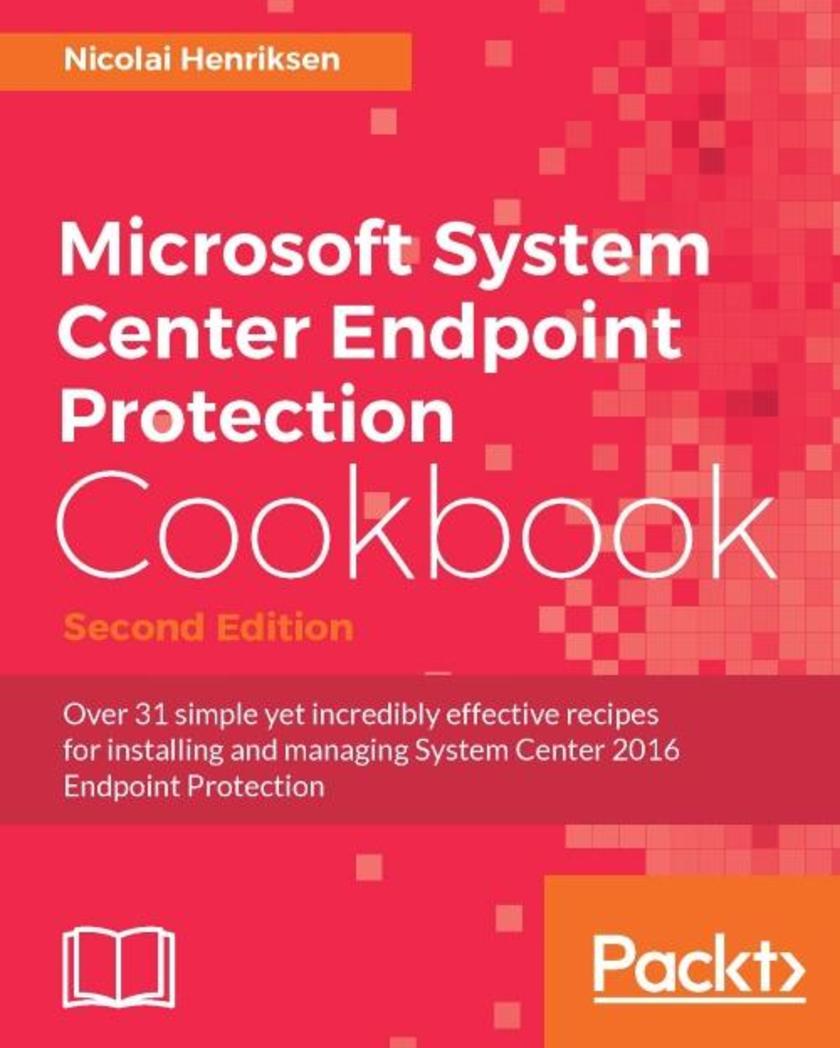
Microsoft System Center Endpoint Protection Cookbook - Second Edition
¥80.65
Over 31 simple yet incredibly effective recipes for installing and managing System Center 2016 Endpoint Protection About This Book This is the most practical and up-to-date book covering important new features of System Center 2016 Endpoint protection Gain confidence in managing IT and protecting your server against malware and other threats Configure and automate reporting features and also prepare yourself for a simple and pain-free migration process Who This Book Is For If you are a System Administrator or Engineer using System Center 2016 Endpoint Protection, then this book is for you. You should have a good background with Microsoft products in general, although no knowledge of Endpoint Protection is required. What You Will Learn Explore the best practices for Endpoint Protection in System Center Configuration Manager Provision the Endpoint Protection Client in a Disk Image in Configuration Manager Get to know more about the Security Center Configure definition and engine client updates to be optimum for your bandwidth Make your application or server work with Endpoint Protection enabled Find out how to deal with typical issues that may occur with Endpoint Protection Know how to respond to infections that often occur In Detail System Center Configuration Manager is now used by over 70% of all the business in the world today and many have taken advantage engaging the System Center Endpoint Protection within that great product. Through this book, you will gain knowledge about System Center Endpoint Protection, and see how to work with it from System Center Configuration Manager from an objective perspective. We’ll show you several tips, tricks, and recipes to not only help you understand and resolve your daily challenges, but hopefully enhance the security level of your business. Different scenarios will be covered, such as planning and setting up Endpoint Protection, daily operations and maintenance tips, configuring Endpoint Protection for different servers and applications, as well as workstation computers. You’ll also see how to deal with malware and infected systems that are discovered. You’ll find out how perform OS deployment, Bitlocker, and Applocker, and discover what to do if there is an attack or outbreak. You’ll find out how to ensure good control and reporting, and great defense against threats and malware software. You’ll see the huge benefits when dealing with application deployments, and get to grips with OS deployments, software updates, and disk encryption such as Bitlocker. By the end, you will be fully aware of the benefits of the System Center 2016 Endpoint Protection anti-malware product, ready to ensure your business is watertight against any threat you could face. Style and approach Build robust SCEP and AV policies and discover the new potential of exciting new features of SCEP 2016.
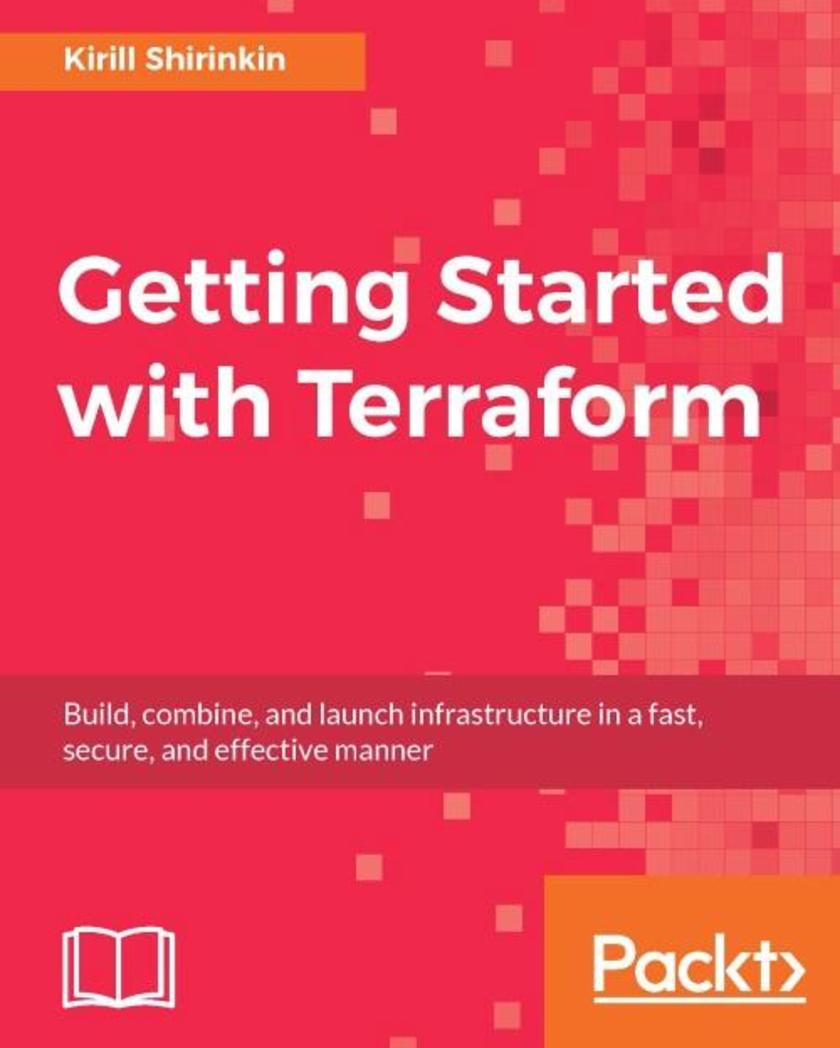
Getting Started with Terraform
¥71.93
Build, combine, and launch infrastructure in a fast, secure, and effective manner About This Book An up-to-date and comprehensive resource on Terraform that lets you quickly and efficiently launch your infrastructure Learn how to implement your infrastructure as code and make secure, effective changes to your infrastructure Learn to build multi-cloud fault-tolerant systems and simplify the management and orchestration of even the largest scale and most complex cloud infrastructures Who This Book Is For This book is for developers and operators who already have some exposure to working with infrastructure but want to improve their workflow and introduce infrastructure as a code practice. Knowledge of essential Amazon Web Services components (EC2, VPC, IAM) would help contextualize the examples provided. Basic understanding of Jenkins and Shell *s will be helpful for the chapters on the production usage of Terraform. What You Will Learn Understand what Infrastructure as Code (IaC) means and why it matters Install, configure, and deploy Terraform Take full control of your infrastructure in the form of code Manage complete complete infrastructure, starting with a single server and scaling beyond any limits Discover a great set of production-ready practices to manage infrastructure Set up CI/CD pipelines to test and deliver Terraform stacks Construct templates to simplify more complex provisioning tasks In Detail Terraform is a tool used to efficiently build, configure, and improve production infrastructure. It can manage existing infrastructure as well as create custom in-house solutions. This book shows you when and how to implement infrastructure as a code practices with Terraform. It covers everything necessary to set up complete management of infrastructure with Terraform, starting with the basics of using providers and resources. This book is a comprehensive guide that begins with very small infrastructure templates and takes you all the way to managing complex systems, all using concrete examples that evolve over the course of the book. It finishes with the complete workflow of managing a production infrastructure as code – this is achieved with the help of version control and continuous integration. At the end of this book, you will be familiar with advanced techniques such as multi-provider support and multiple remote modules. Style and approach This book focuses on providing the practical skills required to make full use of Terraform. It will take the readers slowly from very small infrastructure templates to the managing complex systems, all by using concrete examples, evolving over the course of the book.
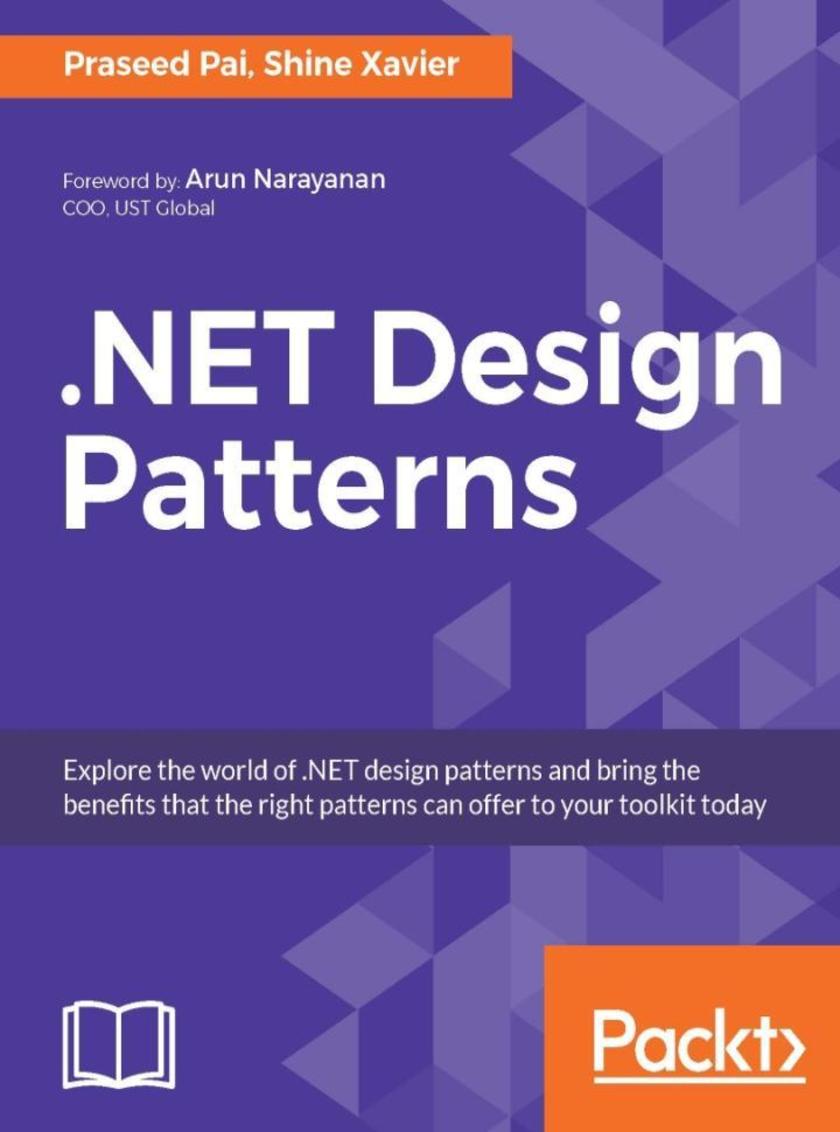
.NET Design Patterns
¥71.93
Explore the world of .NET design patterns and bring the benefits that the right patterns can offer to your toolkit today About This Book This book is based on the latest version of .NET, .NET Core 1.0.·The code is explained piece by piece and the application of the pattern is also showcased. This fast-paced guide shows you how to implement the patterns into your existing applications Who This Book Is For This book is for those with familiarity with .NET development who would like to take their skills to the next level and be in the driver's seat when it comes to modern development techniques. Basic object-oriented C# programming experience and an elementary familiarity with the .NET framework library is required. What You Will Learn Put patterns and pattern catalogs into the right perspective Apply patterns for software development under C#/.NET Use GoF and other patterns in real-life development scenarios Be able to enrich your design vocabulary and well articulate your design thoughts Leverage object/functional programming by mixing OOP and FP Understand the reactive programming model using Rx and RxJs Writing compositional code using C# LINQ constructs Be able to implement concurrent/parallel programming techniques using idioms under .NET Avoiding pitfalls when creating compositional, readable, and maintainable code using imperative, functional, and reactive code. In Detail Knowing about design patterns enables developers to improve their code base, promoting code reuse and making their design more robust. This book focuses on the practical aspects of programming in .NET. You will learn about some of the relevant design patterns (and their application) that are most widely used. We start with classic object-oriented programming (OOP) techniques, evaluate parallel programming and concurrency models, enhance implementations by mixing OOP and functional programming, and finally to the reactive programming model where functional programming and OOP are used in synergy to write better code. Throughout this book, we'll show you how to deal with architecture/design techniques, GoF patterns, relevant patterns from other catalogs, functional programming, and reactive programming techniques. After reading this book, you will be able to convincingly leverage these design patterns (factory pattern, builder pattern, prototype pattern, adapter pattern, facade pattern, decorator pattern, observer pattern and so on) for your programs. You will also be able to write fluid functional code in .NET that would leverage concurrency and parallelism! Style and approach This tutorial-based book takes a step-by-step approach. It covers the major patterns and explains them in a detailed manned along with code examples.
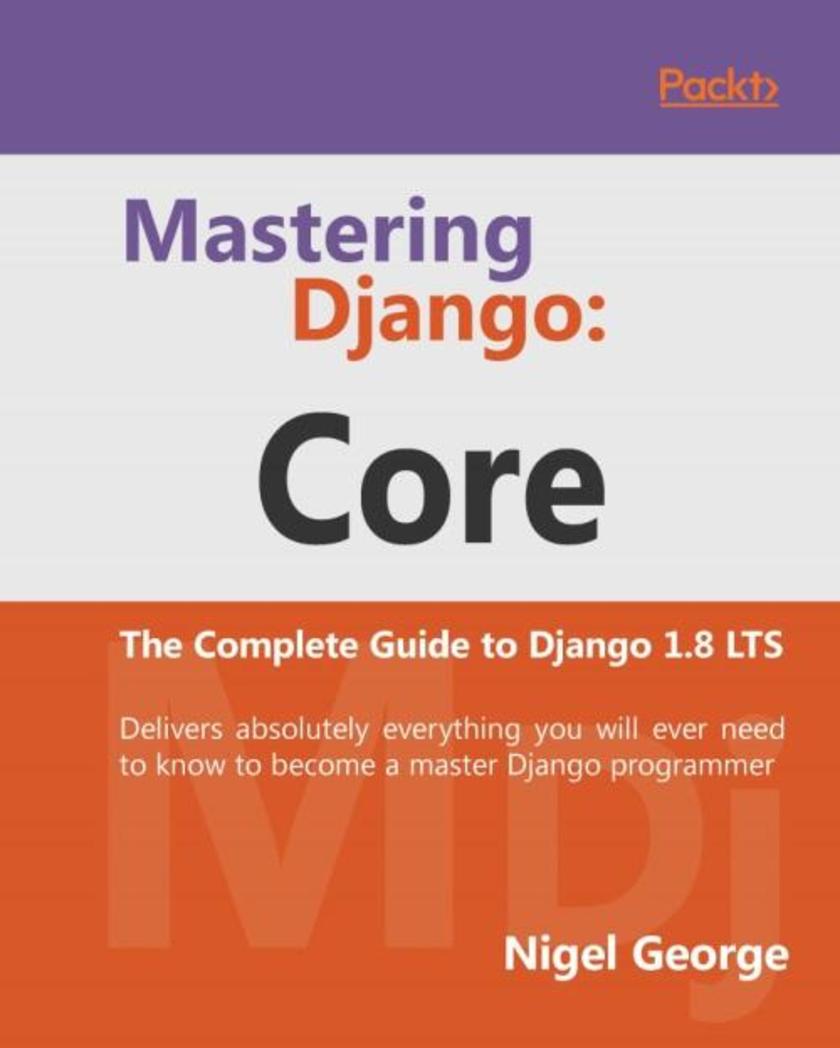
Mastering Django: Core
¥90.46
Delivers absolutely everything you will ever need to know to become a master Django programmer About This Book Gain a complete understanding of Django—the most popular, Python-based web framework in the world Gain the skills to successfully designing, developing, and deploying your app This book is packaged with fully described code so you can learn the fundamentals and the advanced topics to get a complete understanding of all of Django’s core functions Who This Book Is For This book assumes you have a basic understanding of the Internet and programming. Experience with Python or Django would be an advantage, but is not necessary. It is ideal for beginner to intermediate programmers looking for a fast, secure, scalable, and maintainable alternative web development platform to those based on PHP, Java, and dotNET. What You Will Learn Use Django to access user-submitted form data, validate it, and work with it Get to know advanced URLconf tips and tricks Extend Django’s template system with custom code Define models and use the database API to create, retrieve, update, and delete records Fully extend and customize the default implementation as per your project’s needs Test and deploy your Django application Get to know more about Django’s session, cache Framework, and middleware In Detail Mastering Django: Core is a completely revised and updated version of the original Django Book, written by Adrian Holovaty and Jacob Kaplan-Moss - the creators of Django. The main goal of this book is to make you a Django expert. By reading this book, you’ll learn the skills needed to develop powerful websites quickly, with code that is clean and easy to maintain. This book is also a programmer’s manual that provides complete coverage of the current Long Term Support (LTS) version of Django. For developers creating applications for commercial and business critical deployments, Mastering Django: Core provides a complete, up-to-date resource for Django 1.8LTS with a stable code-base, security fixes and support out to 2018. Style and approach This comprehensive step-by-step practical guide offers a thorough understanding of all the web development concepts related to Django. In addition to explaining the features of Django, this book provides real-world experience on how these features fit together to build extraordinary apps.
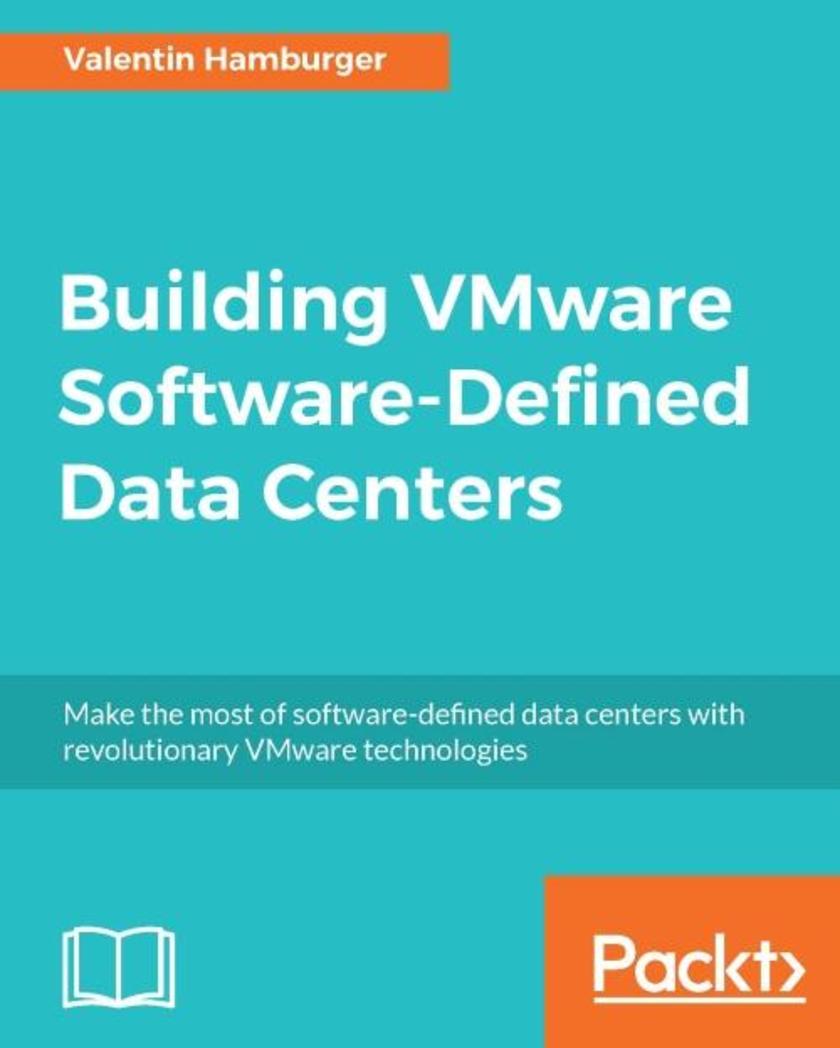
Building VMware Software-Defined Data Centers
¥107.90
Make the most of software-defined data centers with revolutionary VMware technologies About This Book Learn how you can automate your data center operations and deploy and manage applications and services across your public, private, and hybrid infrastructure in minutes Drive great business results with cost-effective solutions without compromising on ease, security, and controls Transform your business processes and operations in a way that delivers any application, anywhere, with complete peace of mind Who This Book Is For If you are an IT professional or VMware administrator who virtualizes data centers and IT infrastructures, this book is for you. Developers and DevOps engineers who deploy applications and services would also find this book useful. Data center architects and those at the CXO level who make decisions will appreciate the value in the content. What You Will Learn Understand and optimize end-to-end processes in your data center Translate IT processes and business needs into a technical design Apply and create vRO workflow automation functionalities to services Deploy NSX in a virtual environment Technically accomplish DevOps offerings Set up and use vROPs to master the SDDC resource demands Troubleshoot all the components of SDDC In Detail VMware offers the industry-leading software-defined data center (SDDC) architecture that combines compute, storage, networking, and management offerings into a single unified platform. This book uses the most up-to-date, cutting-edge VMware products to help you deliver a complete unified hybrid cloud experience within your infrastructure. It will help you build a unified hybrid cloud based on SDDC architecture and practices to deliver a fully virtualized infrastructure with cost-effective IT outcomes. In the process, you will use some of the most advanced VMware products such as VSphere, VCloud, and NSX. You will learn how to use vSphere virtualization in a software-defined approach, which will help you to achieve a fully-virtualized infrastructure and to extend this infrastructure for compute, network, and storage-related data center services. You will also learn how to use EVO:RAIL. Next, you will see how to provision applications and IT services on private clouds or IaaS with seamless accessibility and mobility across the hybrid environment. This book will ensure you develop an SDDC approach for your datacenter that fulfills your organization's needs and tremendously boosts your agility and flexibility. It will also teach you how to draft, design, and deploy toolsets and software to automate your datacenter and speed up IT delivery to meet your lines of businesses demands. At the end, you will build unified hybrid clouds that dramatically boost your IT outcomes. Style and approach With the ever-changing nature of businesses and enterprises, having the capability to navigate through the complexities is of utmost importance. This book takes an approach that combines industry expertise with revolutionary VMware products to deliver a complete SDDC experience through practical examples and techniques, with proven cost-effective benefits.
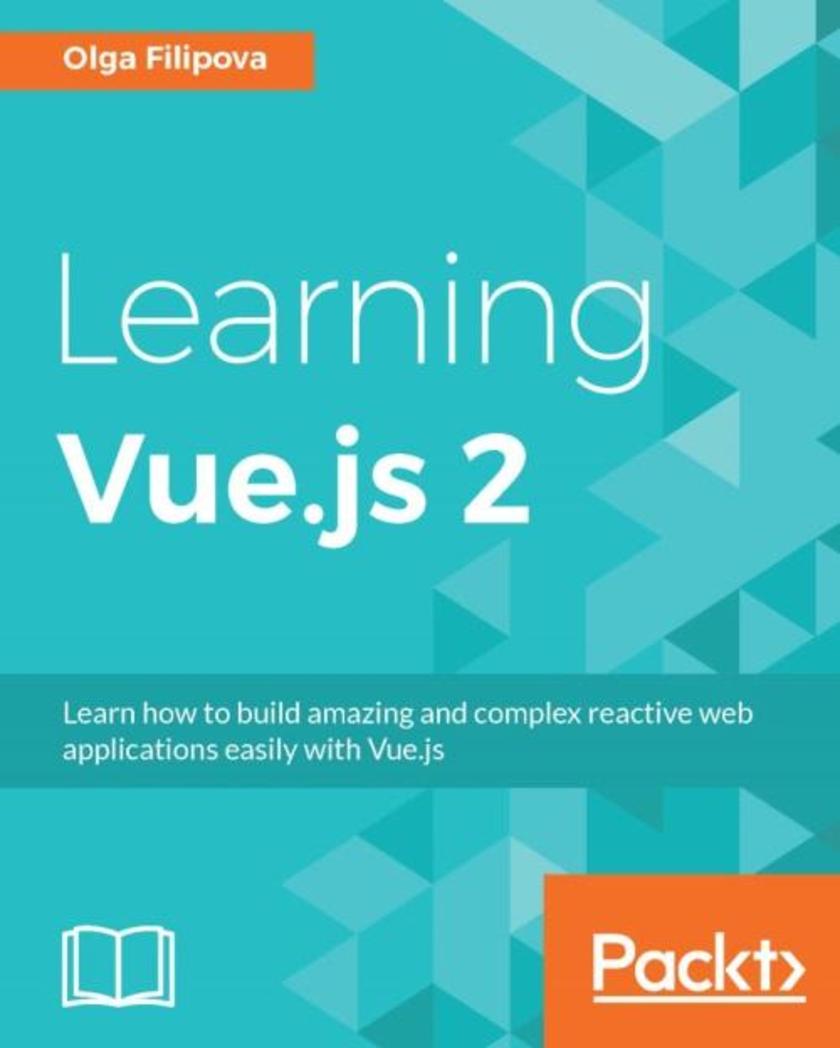
Learning Vue.js 2
¥80.65
Learn how to build amazing and complex reactive web applications easily with Vue.js About This Book Learn how to propagate DOM changes across the website without writing extensive jQuery callbacks code. Learn how to achieve reactivity and easily compose views with Vue.js and understand what it does behind the scenes. Explore the core features of Vue.js with small examples, learn how to build dynamic content into preexisting web applications, and build Vue.js applications from scratch. Who This Book Is For This book is perfect for novice web developer seeking to learn new technologies or frameworks and also for webdev gurus eager to enrich their experience. Whatever your level of expertise, this book is a great introduction to the wonderful world of reactive web apps. What You Will Learn Build a fully functioning reactive web application in Vue.js from scratch. The importance of the MVVM architecture and how Vue.js compares with other frameworks such as Angular.js and React.js. How to bring reactivity to an existing static application using Vue.js. How to use plugins to enrich your applications. How to develop customized plugins to meet your needs. How to use Vuex to manage global application’s state. In Detail Vue.js is one of the latest new frameworks to have piqued the interest of web developers due to its reactivity, reusable components, and ease of use. This book shows developers how to leverage its features to build high-performing, reactive web interfaces with Vue.js. From the initial structuring to full deployment, this book provides step-by-step guidance to developing an interactive web interface from scratch with Vue.js. You will start by building a simple application in Vue.js which will let you observe its features in action. Delving into more complex concepts, you will learn about reactive data binding, reusable components, plugins, filters, and state management with Vuex. This book will also teach you how to bring reactivity to an existing static application using Vue.js. By the time you finish this book you will have built, tested, and deployed a complete reactive application in Vue.js from scratch. Style and approach This book is a thorough, step-by-step guide showing readers how to build complete web apps with Vue.js. While teaching its intricacies, this book shows how to implement the MVVM architecture in the real world and build high-performing web interfaces.
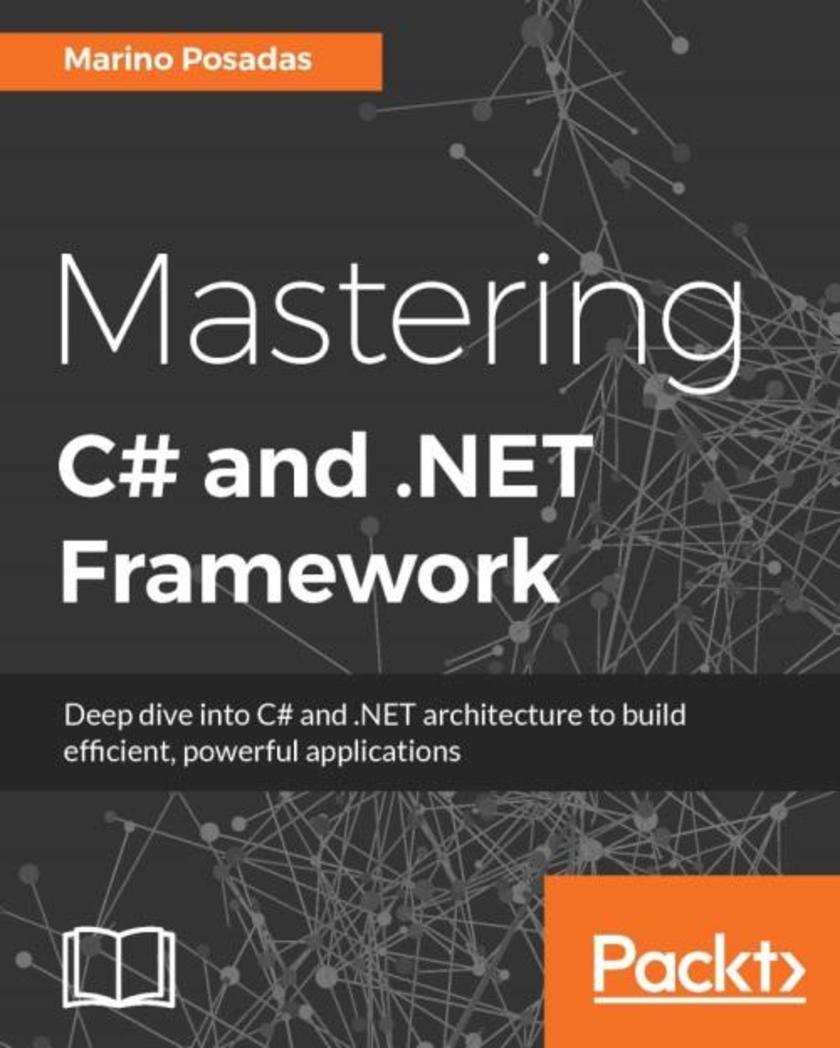
Mastering C# and .NET Framework
¥80.65
Deep dive into C# and .NET architecture to build efficient, powerful applications About This Book Uniquely structured content to help you understand what goes on under the hood of .NET’s managed code platform to master .NET programming Deep dive into C# programming and how the code executes via the CLR Packed with hands-on practical examples, you’ll understand how to write applications to make full use of the new features of .NET 4.6, .NET Core and C# 6/7 Who This Book Is For This book was written exclusively for .NET developers. If you’ve been creating C# applications for your clients, at work or at home, this book will help you develop the skills you need to create modern, powerful, and efficient applications in C#. No knowledge of C# 6/7 or .NET 4.6 is needed to follow along—all the latest features are included to help you start writing cross-platform applications immediately. You will need to be familiar with Visual Studio, though all the new features in Visual Studio 2015 will also be covered. What You Will Learn Understand C# core concepts in depth, from sorting algorithms to the Big O notation Get up to speed with the latest changes in C# 6/7 Interface SQL Server and NoSQL databases with .NET Apprehend SOLID principles and the most relevant GoF Patterns with practical examples in C# 6.0 Defend C# applications against attacks Use Roslyn, a self-hosted framework to compile and advanced edition in both C# and Visual basic .NET languages Discern LINQ and associated Lambda expressions, generics, and delegates Design a .NET application from the ground up Understand the internals of a .NET assembly Grasp some useful advanced features in optimization and parallelism In Detail Mastering C# and .NET Framework will take you in to the depths of C# 6.0/7.0 and .NET 4.6, so you can understand how the platform works when it runs your code, and how you can use this knowledge to write efficient applications. Take full advantage of the new revolution in .NET development, including open source status and cross-platform capability, and get to grips with the architectural changes of CoreCLR. Start with how the CLR executes code, and discover the niche and advanced aspects of C# programming – from delegates and generics, through to asynchronous programming. Run through new forms of type declarations and assignments, source code callers, static using syntax, auto-property initializers, dictionary initializers, null conditional operators, and many others. Then unlock the true potential of the .NET platform. Learn how to write OWASP-compliant applications, how to properly implement design patterns in C#, and how to follow the general SOLID principles and its implementations in C# code. We finish by focusing on tips and tricks that you'll need to get the most from C# and .NET. This book also covers .NET Core 1.1 concepts as per the latest RTM release in the last chapter. Style and approach This book uses hands-on practical code examples that will take you into the depths of C# and .NET. Packed with hands-on practical examples, it is great as a tutorial, or as a reference guide.
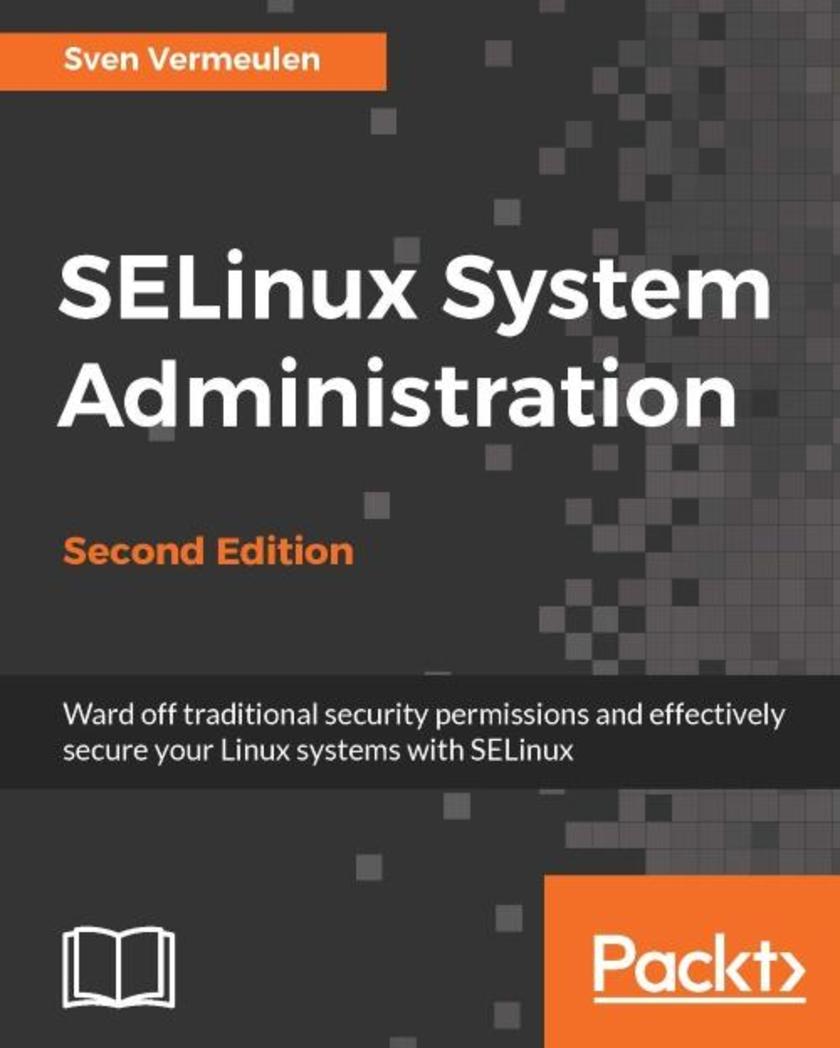
SELinux System Administration - Second Edition
¥90.46
Ward off traditional security permissions and effectively secure your Linux systems with SELinux About This Book Leverage SELinux to improve the secure state of your Linux system A clear approach to adopting SELinux within your organization Essential skills and techniques to help further your system administration career Who This Book Is For This book is for Linux administrators who want to control the secure state of their systems. It’s packed with the latest information on SELinux operations and administrative procedures so you’ll be able to further harden your system through mandatory access control (MAC) – a security strategy that has been shaping Linux security for years. What You Will Learn Analyze SELinux events and selectively enable or disable SELinux enforcement Manage Linux users and associate them with the right role and permission set Secure network communications through SELinux access controls Tune the full service flexibility by dynamically assigning resource labels Handle SELinux access patterns enforced through the system Query the SELinux policy in depth In Detail Do you have the crucial job of protecting your private and company systems from malicious attacks and undefined application behaviorAre you looking to secure your Linux systems with improved access controlsLook no further, intrepid administrator! This book will show you how to enhance your system’s secure state across Linux distributions, helping you keep application vulnerabilities at bay. This book covers the core SELinux concepts and shows you how to leverage SELinux to improve the protection measures of a Linux system. You will learn the SELinux fundamentals and all of SELinux’s configuration handles including conditional policies, constraints, policy types, and audit capabilities. These topics are paired with genuine examples of situations and issues you may come across as an administrator. In addition, you will learn how to further harden the virtualization offering of both libvirt (sVirt) and Docker through SELinux. By the end of the book you will know how SELinux works and how you can tune it to meet your needs. Style and approach This book offers a complete overview of SELinux administration and how it integrates with other components on a Linux system. It covers the majority of SELinux features with a mix of real life scenarios, de*ions, and examples. This book contains everything an administrator needs to customize SELinux.

Windows Server 2016 Hyper-V Cookbook - Second Edition
¥107.90
Save time and resources by getting to know the best practices and intelligence from industry experts About This Book This book helps you gain a fresh perspective through a recipe-based approach on the new Microsoft Server 2016 Hyper-V Over 80 recipes to help you master the administrative tasks of Hyper-V and get to grips with advanced solutions and techniques for virtualization These hands-on advanced recipes will help you deploy, maintain, and upgrade Hyper-V virtual machines Who This Book Is For This book is for Hyper-V administrators who are looking to take advantage of all exciting new features that Microsoft Server 2016 Hyper-V has to offer. What You Will Learn Install and manage Hyper-V in Full, Server Core, and Nano Server Get to know how to migrate and upgrade physical and virtual machines Configure disks, network, memory, security, and auditing settings for virtual machines Take a deep dive into high availability and disaster recovery Save time and money by getting to grips with PowerShell automation Understand the new features around network and nested virtualization, distributed storage QoS, Hyper-V Replica, and much more Gain a full view of your virtual machines and host servers through monitoring, reporting, and troubleshooting tips In Detail Hyper-V is a Windows-based, very cost-effective virtualization solution with easy-to-use and well-known administrative consoles. With this book on your side you will master the worlds of Hyper-V deployment, migration, and management by learning tips, tricks, and best practices, especially when it comes to advanced-level tasks. You will learn how to quickly deploy and automate multiple VMs, and support Hyper-V clusters through different installation methods. You will learn the concepts efficiently with the help of up-to-date real-world examples and improve the scalability and efficiency of large-scale VM deployments with Nano Server. By the end of this book, you will be an ace Windows Server 2016 Hyper-V with the skills needed to administer and manage it effectively and survive in the brave new world of mobile-first, cloud-first. Further, take advantage of bonus appendix explaining Hyper-V and backup architecture and the difference between versions. Style and approach This advanced-level book provides step-by-step recipes on real-world examples so you can get practical, hands-on experience of the subjects.
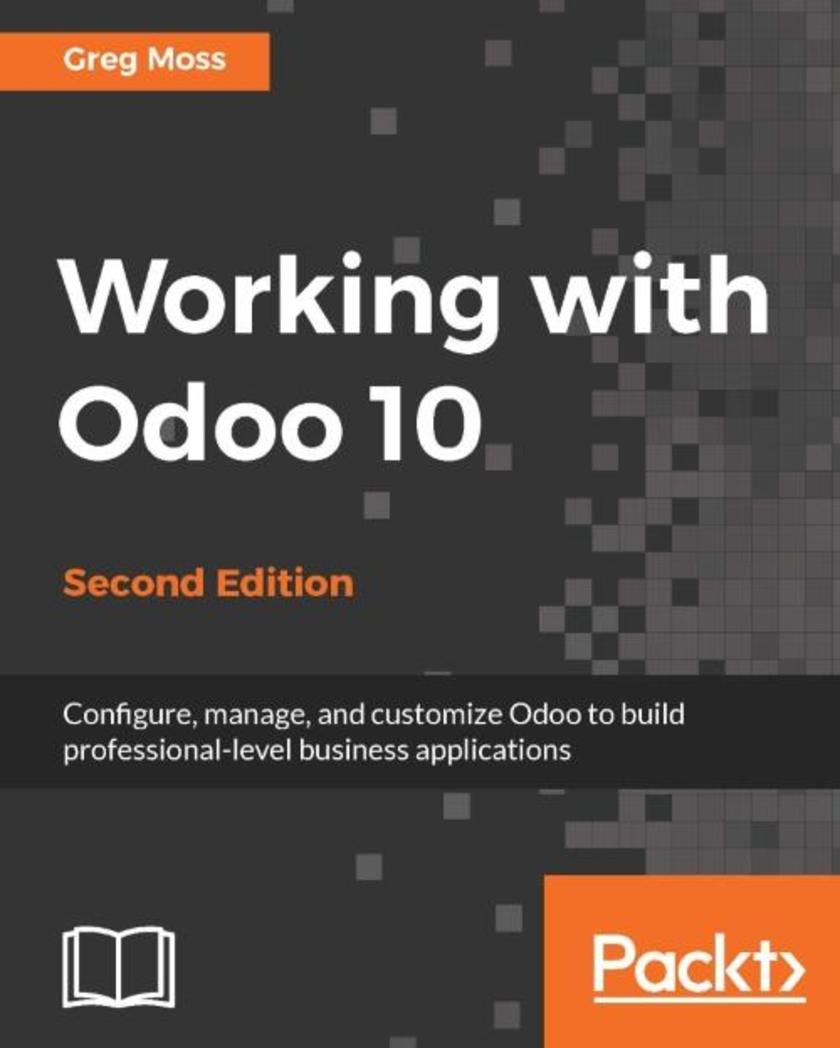
Working with Odoo 10 - Second Edition
¥90.46
Configure, manage, and customize Odoo to build professional-level business applications About This Book Build an Odoo module and integrate it with other platforms through this practical guide This book is the perfect companion to help you customize your Odoo installations for your enterprise requirements Use project management along with analytics for better reporting Who This Book Is For This book is for those who have not used Odoo before, allowing you to learn advanced-level features with Odoo such as creating your own custom modules. You do not need any knowledge of Odoo. What You Will Learn Configure a functioning customer relationship management system Set up a purchasing and receiving system Implement manufacturing operations and processes using real-world examples Discover the capabilities of Odoo's financial accounting and reporting features Integrate powerful human resource applications Utilize Odoo's project management application to organize tasks Customize Odoo without writing a line a code In Detail Odoo is a comprehensive set of open-source enterprise management applications. Now with Odoo 10, you have access to a powerful website builder, integrated e-commerce features, and a fast-growing community to help transform and modernize your business. You will start with how to set up Odoo online and on your own server. You’ll then configure the basic company settings required to quickly getting your first Odoo system up and running. Later you’ll explore Customer Relationship Management in Odoo and and their importance in today's modern business environment. Next we will deep dive into purchasing application with Odoo and learn some of the primary functionalities of ERP systems for manufacturing operations. You will then use analytic accounting to provide better reporting. Finally you will walk through the recent Odoo 10 features with respect to the community and enterprise edition giving you complete understanding of what Odoo can do for you no matter the reason! Style and approach This fast-paced, step-by-step guide will show you everything you need to know about the Odoo module ecosystem through practical and real-world examples.
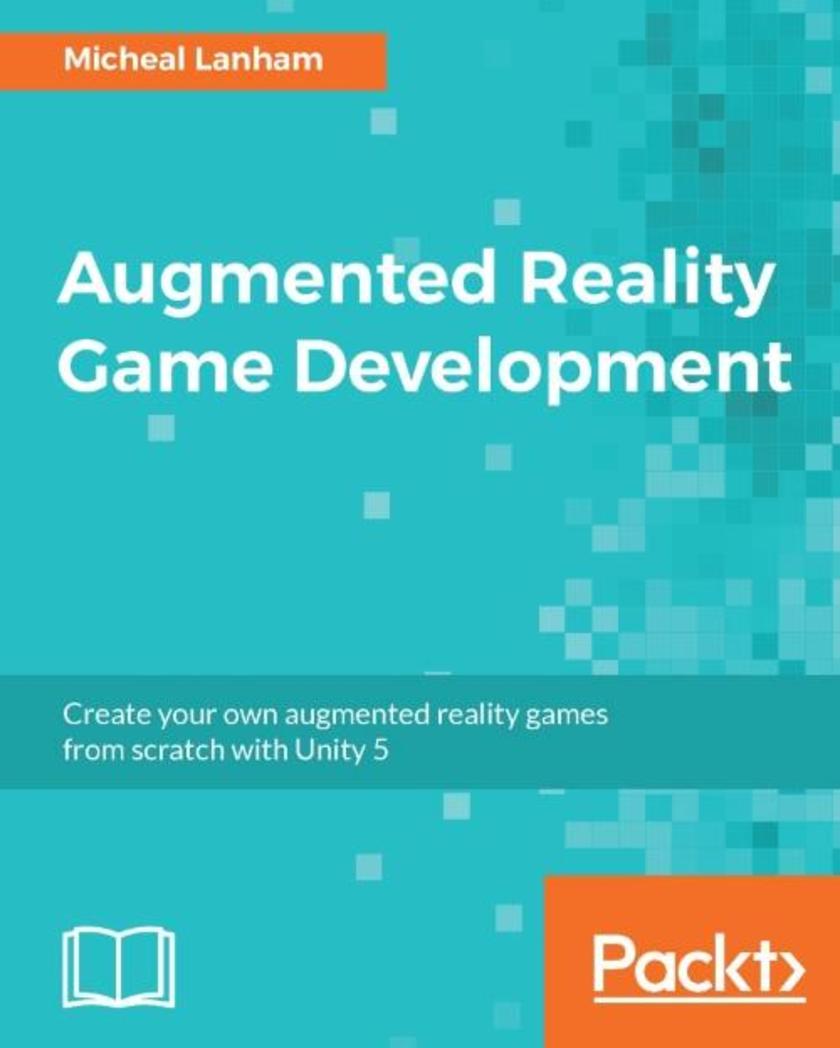
Augmented Reality Game Development
¥80.65
Create your own augmented reality games from scratch with Unity 5 About This Book Create your own augmented reality game from scratch and join the virtual reality gaming revolution Use the latest Unity 5 VR SDK to create pro-level AR games like Pokémon Go Innovate and explore the latest and most promising trend of AR gaming in the mobile gaming industry Who This Book Is For This book is for those who have a basic knowledge of game development techniques, but no previous knowledge of Unity is required. Some basic programming knowledge would be desirable, but the book is an introduction to the topic. The book is also suitable for experienced developers new to GIS or GPS development. What You Will Learn Build a location-based augmented reality game called Foodie Go Animate a player’s avatar on a map Use the mobile device’s camera as a game background Implement database persistence with SQLLite4Unity3D to carry inventory items across game sessions Create basic UI elements for the game, inventory, menu, and settings Perform location and content searches against the Google Places API Enhance the game’s mood by adding visual shader effects Extend the game by adding multiplayer networking and other enhancements In Detail The heyday of location-based augmented reality games is upon us. They have been around for a few years, but the release of Pokémon Go was a gamechanger that catalyzed the market and led to a massive surge in demand. Now is the time for novice and experienced developers alike to turn their good ideas into augmented reality (AR) mobile games and meet this demand! If you are keen to develop virtual reality games with the latest Unity 5 toolkit, then this is the book for you. The genre of location-based AR games introduces a new platform and technical challenges, but this book will help simplify those challenges and show how to maximize your game audience. This book will take you on a journey through building a location-based AR game that addresses the core technical concepts: GIS fundamentals, mobile device GPS, mapping, map textures in Unity, mobile device camera, camera textures in Unity, accessing location-based services, and other useful Unity tips. The technical material also discusses what is necessary for further development to create a multiplayer version of the game. At the end, you will be presented with troubleshooting techniques in case you get into trouble and need a little help. Style and approach This book shows you how to create every step of the game and gives practical examples.
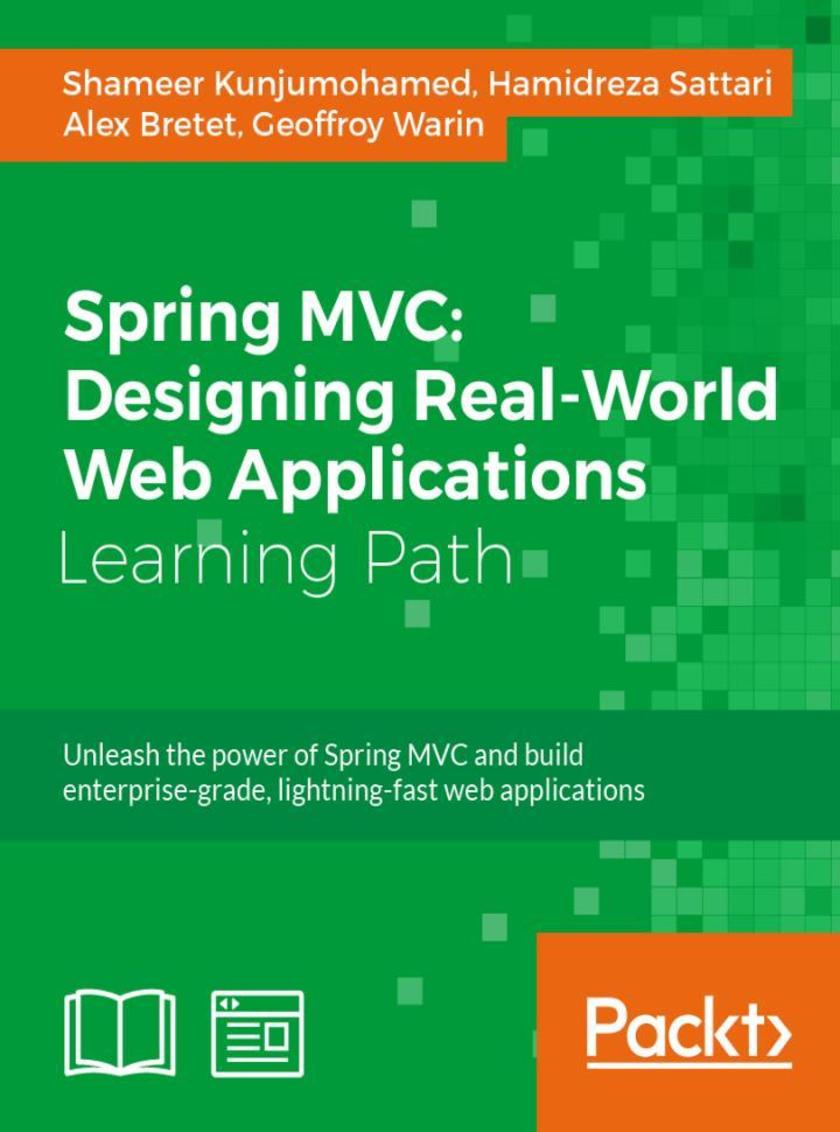
Spring MVC: Designing Real-World Web Applications
¥179.84
Unleash the power of Spring MVC and build enterprise-grade, lightning-fast web applications About This Book Configure Spring MVC to build logic-less controllers that transparently support the most advanced web techniques Secure your developments with easy-to-write, reliable unit and end-to-end tests Get this fast-paced, practical guide to produce REST resources and templates as required by the latest front-end best practices Who This Book Is For This Learning Path is for Java developers who want to exploit Spring MVC and its features to build web applications. It will help you step up in your career and stay up to date or learn more about Spring’s web scalability. What You Will Learn Set up and build standalone and web-based projects using Spring Framework with Maven or Gradle Develop RESTful API applications for XML and JSON data transfers Investigate Spring data access mechanisms with Spring Data Repositories Generate templates for a responsive and powerful front end with AngularJS and Bootstrap Authenticate over REST with a BASIC authentication scheme and OAuth2; handle roles and permissions Communicate through WebSocket and STOMP messages Design complex advanced-level forms and validate the model Create maintainable unit and acceptance tests to secure the apps Deploy the web application to the cloud in a snap In Detail Spring MVC helps you build flexible and loosely coupled web applications. The Spring MVC Framework is designed in such a way that every piece of logic and functionality is highly configurable. This Learning Path aims to make you an expert in designing web applications with Spring MVC 4. In our first module, we’ll begin with an introduction to the Spring framework. You'll then learn aspect-oriented programming. Packed with real-world examples, you’ll get an insight into how you can use Spring Expression Language in your applications to make them easier to manage and maintain. In the second module, you'll learn everything you need to build modern Spring-based enterprise web applications. From practical development techniques and useful tools from the wider Spring ecosystem, to the new JEE standards, the impact of JavaScript, and even the Internet of Things, you'll feel confident that you can deploy Spring for an impressive range of creative purposes. In the final module, you'll find out how to take advantage of Spring MVC's advanced features - essential if you are to properly master the framework. To do this you'll investigate the inner mechanics of Spring MVC, and how they tie into to the broader principles that inform many modern web architectures. With further guidance on how to test, secure, and optimize your application, as well as designing RESTful services, you'll very quickly be ready to use Spring in your next web project. This Learning Path combines some of the best that Packt has to offer in one complete, curated package. It includes content from the following Packt products: Spring Essentials by Shameer Kunjumohamed, Hamidreza Sattari Spring MVC Cookbook by Alex Bretet Mastering Spring MVC 4 by Geoffroy Warin Style and approach This is a hands-on, practical guide based on logical modules of the whole Spring framework family, employing a combination of theory and examples with pro-level practices, techniques, and solutions.
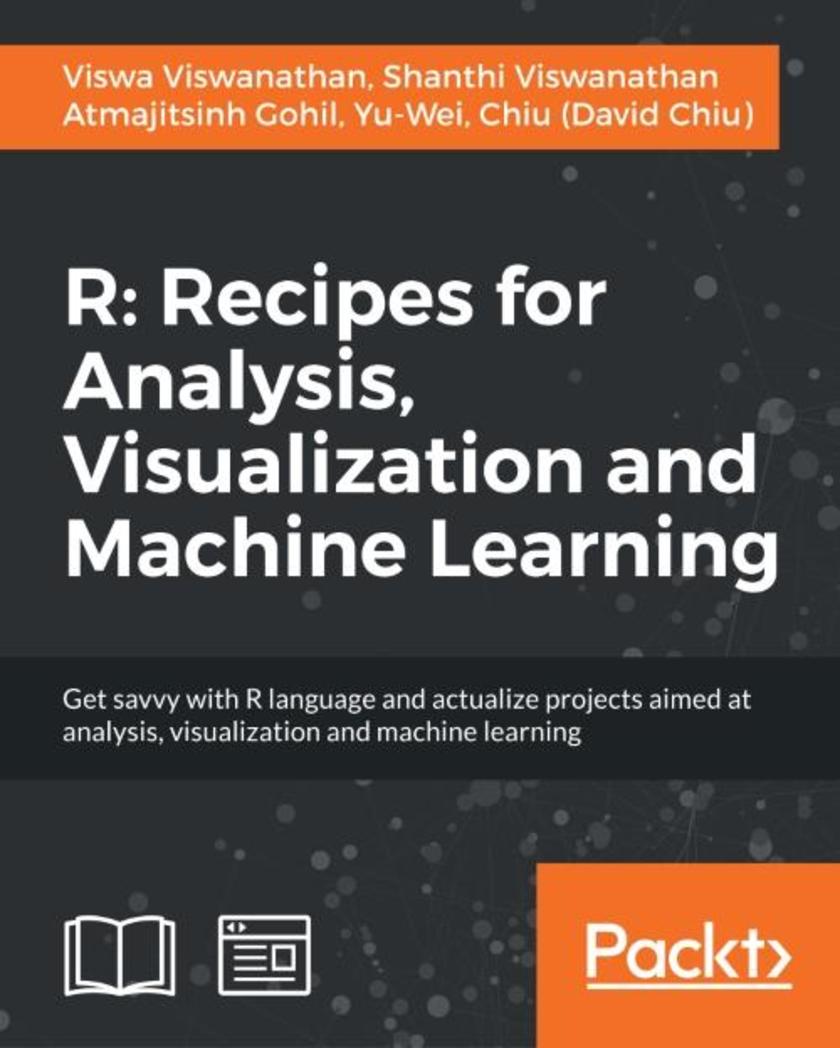
R: Recipes for Analysis, Visualization and Machine Learning
¥161.31
Get savvy with R language and actualize projects aimed at analysis, visualization and machine learning About This Book Proficiently analyze data and apply machine learning techniques Generate visualizations, develop interactive visualizations and applications to understand various data exploratory functions in R Construct a predictive model by using a variety of machine learning packages Who This Book Is For This Learning Path is ideal for those who have been exposed to R, but have not used it extensively yet. It covers the basics of using R and is written for new and intermediate R users interested in learning. This Learning Path also provides in-depth insights into professional techniques for analysis, visualization, and machine learning with R – it will help you increase your R expertise, regardless of your level of experience. What You Will Learn Get data into your R environment and prepare it for analysis Perform exploratory data analyses and generate meaningful visualizations of the data Generate various plots in R using the basic R plotting techniques Create presentations and learn the basics of creating apps in R for your audience Create and inspect the transaction dataset, performing association analysis with the Apriori algorithm Visualize associations in various graph formats and find frequent itemset using the ECLAT algorithm Build, tune, and evaluate predictive models with different machine learning packages Incorporate R and Hadoop to solve machine learning problems on big data In Detail The R language is a powerful, open source, functional programming language. At its core, R is a statistical programming language that provides impressive tools to analyze data and create high-level graphics. This Learning Path is chock-full of recipes. Literally! It aims to excite you with awesome projects focused on analysis, visualization, and machine learning. We’ll start off with data analysis – this will show you ways to use R to generate professional analysis reports. We’ll then move on to visualizing our data – this provides you with all the guidance needed to get comfortable with data visualization with R. Finally, we’ll move into the world of machine learning – this introduces you to data classification, regression, clustering, association rule mining, and dimension reduction. This Learning Path combines some of the best that Packt has to offer in one complete, curated package. It includes content from the following Packt products: R Data Analysis Cookbook by Viswa Viswanathan and Shanthi Viswanathan R Data Visualization Cookbook by Atmajitsinh Gohil Machine Learning with R Cookbook by Yu-Wei, Chiu (David Chiu) Style and approach This course creates a smooth learning path that will teach you how to analyze data and create stunning visualizations. The step-by-step instructions provided for each recipe in this comprehensive Learning Path will show you how to create machine learning projects with R.
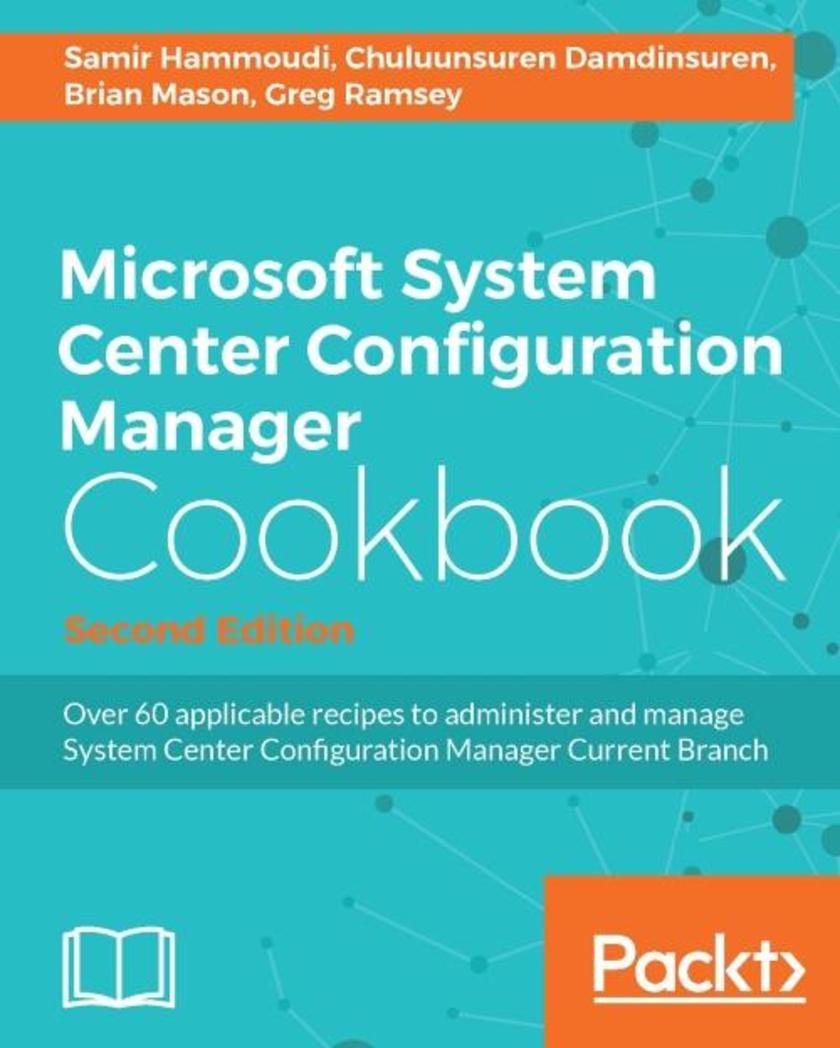
Microsoft System Center Configuration Manager Cookbook - Second Edition
¥107.90
Over 60 applicable recipes to administer and manage System Center Configuration Manager Current Branch About This Book Overcome the challenges of administering System Center Configuration Manager when deploying single and multiple-hierarchy sites Help your organization to build a custom-line of business apps and also protect the server against malware threats with Endpoint protection Get easy guidance and best practices to help you work with SCCM Who This Book Is For If you are an intermediate to advanced administrator who wants to administer SCCM and understand how to solve particular problems/scenarios, then this book is for you. You should have a working knowledge of SCCM, however, knowledge of the latest version is not required. What You Will Learn Administer System Center Configuration Manager Upgrade computers from Windows 7/ 8.x to Windows 10, using Serivce Plans to keep Windows 10 machines up to date Manage Compliance Settings effectively and monitor it with SSRS Manage Sites in System Center Configuration Manager and also learn to create collections, leverage role-based administration (RBA), and support clients over the internet without a VPN connection Implement multiple methods to deploy the client, as well as how to be proactive in monitoring client agent health Achieve Mobile device management with Microsoft Intune In Detail This practical cookbook is based on the 1602 current branch of System Center Configuration Manager (SCCM). It shows you how to administer SCCM, giving you an essential toolbox of techniques to solve real-world scenarios. Packed with over 60 task-based and instantly usable recipes, you’ll discover how design a SCCM Infrastructure, and dive into topics such as the recommended SQL configuration for SCCM and how to deploy Windows 10 with Operating System Deployment (OSD). You will learn to easily manage Windows 10 devices by deploying applications, software updates, and feature upgrades, andl be able to leverage Mobile Device Management (MDM) using SCCM and Microsoft Intune. Finally, you see how to gather the inventory of all your PC park and create reports based on it. By the end of the book, you will have learned the best practices when working with SCCM and have a handy reference guide for troubleshooting. Style and approach This cookbook is full of quick recipes that show you how to administer SCCM and will help you understand how to solve particular problems/situations encountered in day-to-day tasks.
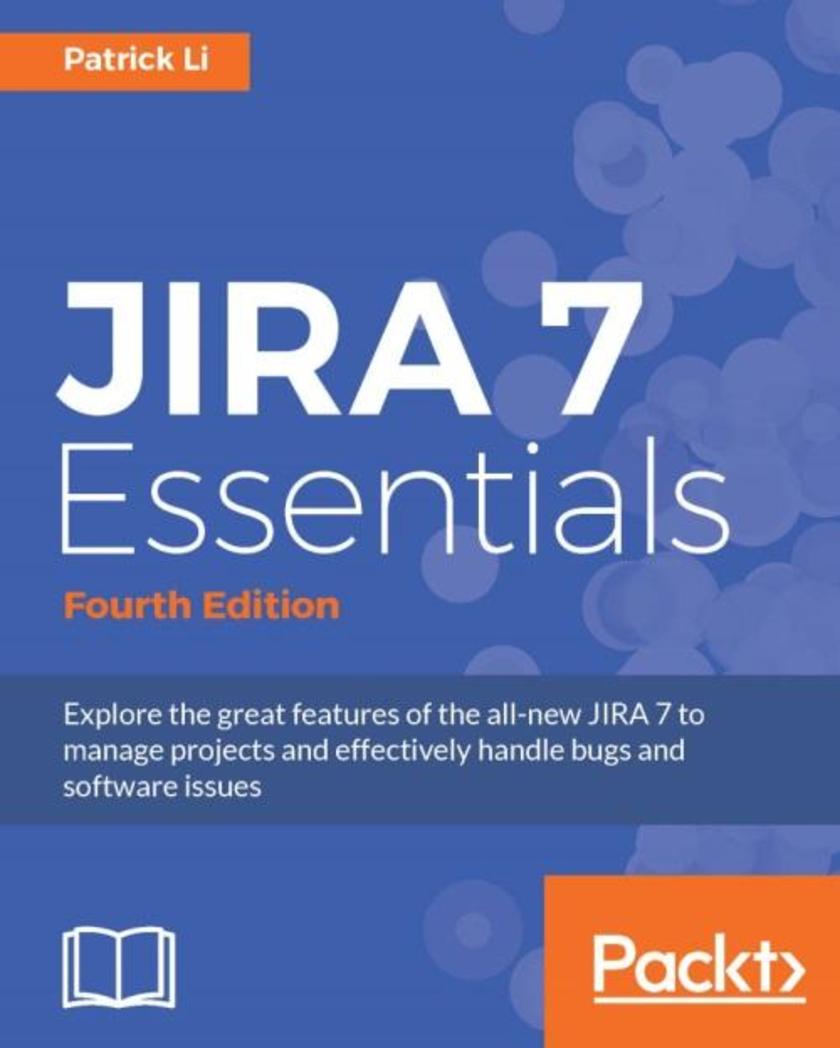
JIRA 7 Essentials - Fourth Edition
¥107.90
Explore the great features of the all-new JIRA 7 to manage projects and effectively handle bugs and software issues About This Book Updated for JIRA 7, this book covers all the new features introduced in JIRA 7 with a dedicated chapter on JIRA Service Desk—one of the biggest new add-ons to JIRA This book lays a strong foundation to work with agile projects in JIRA from both the administrator and end user's perspective Work through step-by-step exercises at the end of each chapter for you to try out and reinforce your skills Who This Book Is For This book will be especially useful for project managers but it's also intended for other JIRA users, including developers, and any other industry besides software development, who would like to leverage JIRA’s powerful task management and workflow features to better manage their business processes. What You Will Learn Understand JIRA's data hierarchy and how to design and work with projects in JIRA Plan and set up a new JIRA 7 instance from scratch for production use Using JIRA for agile software projects, business process management, customer service support, and more Understand issues and work with them Design both system and custom fields to behave differently under different contexts Create and design your own screens and apply them to different project and issue types Gain an understanding of the workflow and its various components Set up both incoming and outgoing mail servers to work with e-mails In Detail Atlassian JIRA is an enterprise-issue tracker system. One of its key strengths is its ability to adapt to the needs of the organization, ranging from building Atlassian application interfaces to providing a platform for add-ons to extend JIRA's capabilities. JIRA 7 Essentials, now in its fourth edition, provides a comprehensive explanation covering all major components of JIRA 7, which includes JIRA Software, JIRA Core, and JIRA Service Works. The book starts by explaining how to plan and set up a new JIRA 7 instance from scratch for production use before moving on to the more key features such as e-mails, workflows, business processes, and so on. Then you will understand JIRA's data hierarchy and how to design and work with projects in JIRA. Issues being the corner stone of using JIRA, you will gain a deep understanding of issues and their purpose. Then you will be introduced to fields and how to use custom fields for more effective data collections. You will then learn to create new screens from scratch and customize it to suit your needs. The book then covers workflows and business processes, and you will also be able to set up both incoming and outgoing mail servers to work with e-mails. Towards the end, we explain JIRA's security model and introduce you to one of JIRA’s new add-ons: JIRA Service Desk, which allows you to run JIRA as a computer support portal. Style and approach This is a comprehensive, practical guide on using JIRA to efficiently manage all your projects. It provides clear, step-by-step explanations, and shows how you can use the various features of JIRA to manage your projects more efficiently.
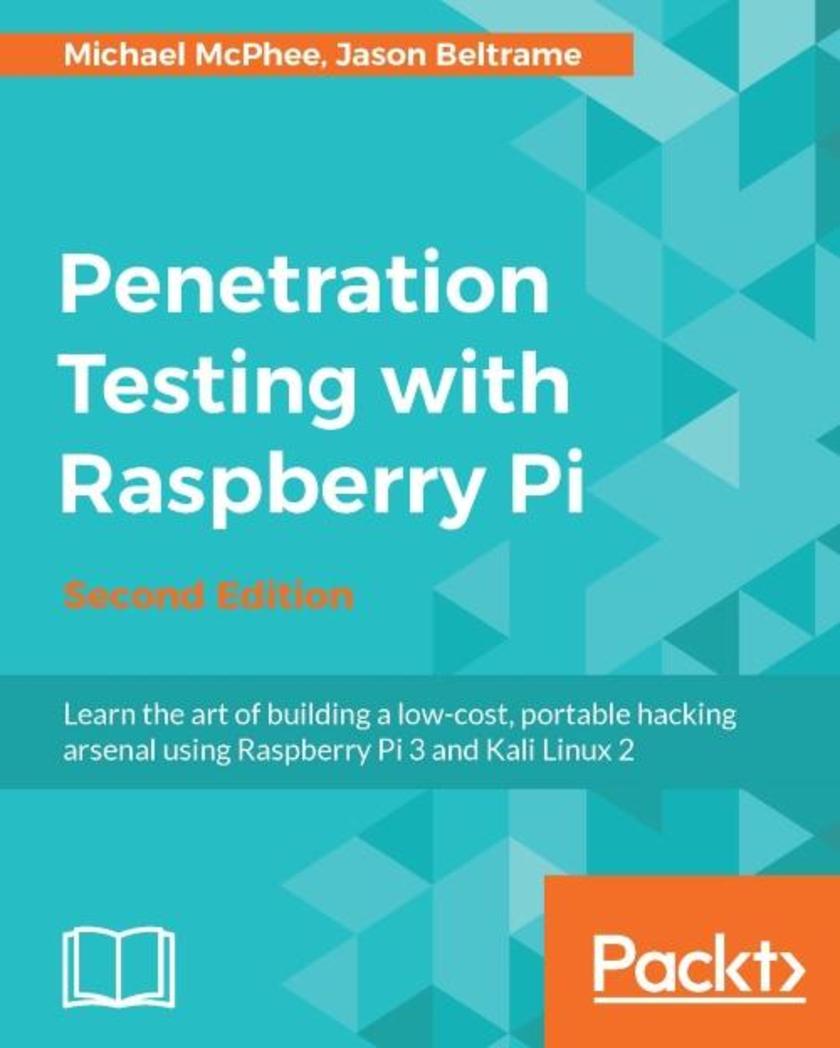
Penetration Testing with Raspberry Pi - Second Edition
¥71.93
Learn the art of building a low-cost, portable hacking arsenal using Raspberry Pi 3 and Kali Linux 2 About This Book Quickly turn your Raspberry Pi 3 into a low-cost hacking tool using Kali Linux 2 Protect your confidential data by deftly preventing various network security attacks Use Raspberry Pi 3 as honeypots to warn you that hackers are on your wire Who This Book Is For If you are a computer enthusiast who wants to learn advanced hacking techniques using the Raspberry Pi 3 as your pentesting toolbox, then this book is for you. Prior knowledge of networking and Linux would be an advantage. What You Will Learn Install and tune Kali Linux 2 on a Raspberry Pi 3 for hacking Learn how to store and offload pentest data from the Raspberry Pi 3 Plan and perform man-in-the-middle attacks and bypass advanced encryption techniques Compromise systems using various exploits and tools using Kali Linux 2 Bypass security defenses and remove data off a target network Develop a command and control system to manage remotely placed Raspberry Pis Turn a Raspberry Pi 3 into a honeypot to capture sensitive information In Detail This book will show you how to utilize the latest credit card sized Raspberry Pi 3 and create a portable, low-cost hacking tool using Kali Linux 2. You’ll begin by installing and tuning Kali Linux 2 on Raspberry Pi 3 and then get started with penetration testing. You will be exposed to various network security scenarios such as wireless security, scanning network packets in order to detect any issues in the network, and capturing sensitive data. You will also learn how to plan and perform various attacks such as man-in-the-middle, password cracking, bypassing SSL encryption, compromising systems using various toolkits, and many more. Finally, you’ll see how to bypass security defenses and avoid detection, turn your Pi 3 into a honeypot, and develop a command and control system to manage a remotely-placed Raspberry Pi 3. By the end of this book you will be able to turn Raspberry Pi 3 into a hacking arsenal to leverage the most popular open source toolkit, Kali Linux 2.0. Style and approach This concise and fast-paced guide will ensure you get hands-on with penetration testing right from the start. You will quickly install the powerful Kali Linux 2 on your Raspberry Pi 3 and then learn how to use and conduct fundamental penetration techniques and attacks.

MEAN Web Development - Second Edition
¥80.65
Develop your real-time MEAN application efficiently using a combination of MongoDB, Express, Angular, and Node About This Book Construct a fully-functional MEAN application by using its components along with the best third-party modules Harness the power of the JavaScript ecosystem to effectively run, build, and test your MEAN application Gain a deep, practical understanding of real-time web application development through real-world examples Who This Book Is For If you are a JavaScript developer who is interested in building modern web applications using MongoDB, Express, Angular 2, and Node 5.0, then this book is for you. You only need knowledge of JavaScript development. What You Will Learn Use MongoDB to store and retrieve your application's data Connect your Express application to MongoDB and use the Mongoose module Manage your users' authentication and offer them diverse login options using Passport Structure and use an Angular 2 application in your MEAN project Use Socket.io to create real-time communication between your client and server Test your application's Express and Angular 2 entities In Detail The MEAN stack is a collection of the most popular modern tools for web development that helps you build fast, robust, and maintainable web applications. Starting with the MEAN core frameworks, this pragmatic guide will explain the key concepts of each framework, how to set them up properly, and how to use popular modules to connect it all together. By following the real-world examples shown in this tutorial, you will scaffold your MEAN application architecture, add an authentication layer, and develop an MVC structure to support your project development. You will learn the best practices of maintaining clear and simple code and will see how to avoid common pitfalls. Finally, you will walk through the different tools and frameworks that will help expedite your daily development cycles. Watch how your application development grows by learning from the only guide that is solely orientated towards building a full, end-to-end, real-time application using the MEAN stack! Style and approach This comprehensive guide covers every part of the MEAN stack, and focuses on the gestalt power of the apps they can create through practical, real-world examples




 购物车
购物车 个人中心
个人中心



